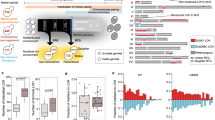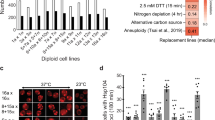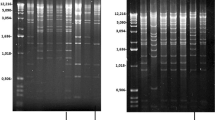Abstract
Four mutations of the a mating type locus of Saccharomyces cerevisiae have been analysed to determine their relationship to the a mating type locus. Matα+ recombinants are produced by matα2−/MATa but not by matα1−/MATa diploids. MATα and MATa thus contain regions of homology (coding for at least part of MATα2) and regions of non-homology (coding for at least part of MATα1)—the genetic determinant for cell type is larger than the non-homologous sequence seen by DNA–DNA heteroduplexes and genetic analysis. The segment transposed in mating type interconversion includes both types of sequence.
This is a preview of subscription content, access via your institution
Access options
Subscribe to this journal
Receive 51 print issues and online access
$199.00 per year
only $3.90 per issue
Buy this article
- Purchase on Springer Link
- Instant access to full article PDF
Prices may be subject to local taxes which are calculated during checkout
Similar content being viewed by others
References
MacKay, V. L. & Manney, T. R. Genetics 76, 273–288 (1974).
Strathern, J. N., Hicks, J. B. & Herskowitz, I. J. molec. Biol. (in the press).
Herskowitz, I. et al. in The Molecular Genetics of Development (eds Loomis, W. & Leighton,T.) 79–118 (Academic, New York, 1980).
Kassir, Y. & Simchen, G. Genetics 82, 187–202 (1976).
Klar, A. J. S., Fogel, S. & Radin, D. N. Genetics 92, 759–776 (1979).
Nasmyth, K. A. & Tatchell, K. Cell 19, 753–764 (1980).
Strathern, J. N., Spatola, E., McGill, C. & Hicks, J. B. Proc. natn. Acad. Sci. U.S.A. 77, 2839–2843 (1980).
MacKay, V. L. & Manney, T. R. Genetics 76, 255–271 (1974).
Herskowitz, L., Rine, J., Sprague, G. Jr & Jensen, R. in Mobilization and Reassembly of Genetic Information Vol. 17 (eds Scott, W. A., Werner, R., Schultz, J. & Joseph, D. R.) 133–151 (Academic, New York, 1980).
Rine, J., Strathern, J. N., Hicks, J. B. & Herskowitz, I. Genetics 93, 877–901 (1979).
Klar, A. J. S., Strathern, J. N., Broach, J. R. & Hicks, J. B. Nature 289, 239–244 (1980).
Nasmyth, K. A., Tatchell, K., Hall, B. D., Astell, C. & Smith, A. Nature 289, 244–250 (1980).
Hicks, J. B. & Herskowitz, I. Genetics 85, 373–393 (1977).
Strathern, J. N., Blair, L. C. & Herskowitz, I. Proc. natn. Acad. Sci. U.S.A. 76, 3425–3429 (1979).
Skogerson, L., McLaughlin, C. S. & Wakatama, E. J. Bact. 116, 818–822 (1973).
Author information
Authors and Affiliations
Rights and permissions
About this article
Cite this article
Sprague, G., Rine, J. & Herskowitz, I. Homology and non-homology at the yeast mating type locus. Nature 289, 250–252 (1981). https://doi.org/10.1038/289250a0
Received:
Accepted:
Issue Date:
DOI: https://doi.org/10.1038/289250a0
This article is cited by
-
Cloning of the mating-type gene MATA of the yeast Yarrowia lipolytica
Molecular and General Genetics MGG (1992)
-
Homoeo-domain homology in yeast MATα2 is essential for repressor activity
Nature (1986)
-
Control of the production of the sexual agglutination substances by the mating type locus inSaccharomyces cerevisiae: Simultaneous expression of specific genes fora and α agglutination substances inmat α2 mutant cells
Molecular and General Genetics MGG (1982)
Comments
By submitting a comment you agree to abide by our Terms and Community Guidelines. If you find something abusive or that does not comply with our terms or guidelines please flag it as inappropriate.



